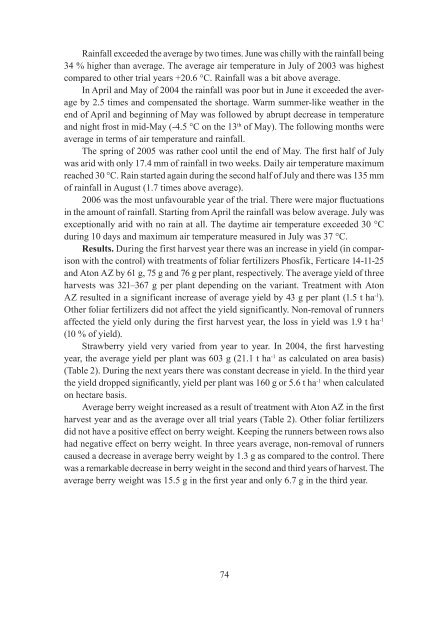SodininkyStÄ ir darŽininkyStÄ 28(4)
SodininkyStÄ ir darŽininkyStÄ 28(4)
SodininkyStÄ ir darŽininkyStÄ 28(4)
Create successful ePaper yourself
Turn your PDF publications into a flip-book with our unique Google optimized e-Paper software.
Rainfall exceeded the average by two times. June was chilly with the rainfall being<br />
34 % higher than average. The average a<strong>ir</strong> temperature in July of 2003 was highest<br />
compared to other trial years +20.6 °C. Rainfall was a bit above average.<br />
In April and May of 2004 the rainfall was poor but in June it exceeded the average<br />
by 2.5 times and compensated the shortage. Warm summer-like weather in the<br />
end of April and beginning of May was followed by abrupt decrease in temperature<br />
and night frost in mid-May (-4.5 °C on the 13 th of May). The following months were<br />
average in terms of a<strong>ir</strong> temperature and rainfall.<br />
The spring of 2005 was rather cool until the end of May. The f<strong>ir</strong>st half of July<br />
was arid with only 17.4 mm of rainfall in two weeks. Daily a<strong>ir</strong> temperature maximum<br />
reached 30 °C. Rain started again during the second half of July and there was 135 mm<br />
of rainfall in August (1.7 times above average).<br />
2006 was the most unfavourable year of the trial. There were major fluctuations<br />
in the amount of rainfall. Starting from April the rainfall was below average. July was<br />
exceptionally arid with no rain at all. The daytime a<strong>ir</strong> temperature exceeded 30 °C<br />
during 10 days and maximum a<strong>ir</strong> temperature measured in July was 37 °C.<br />
Results. During the f<strong>ir</strong>st harvest year there was an increase in yield (in comparison<br />
with the control) with treatments of foliar fertilizers Phosfik, Ferticare 14-11-25<br />
and Aton AZ by 61 g, 75 g and 76 g per plant, respectively. The average yield of three<br />
harvests was 321–367 g per plant depending on the variant. Treatment with Aton<br />
AZ resulted in a significant increase of average yield by 43 g per plant (1.5 t ha -1 ).<br />
Other foliar fertilizers did not affect the yield significantly. Non-removal of runners<br />
affected the yield only during the f<strong>ir</strong>st harvest year, the loss in yield was 1.9 t ha -1<br />
(10 % of yield).<br />
Strawberry yield very varied from year to year. In 2004, the f<strong>ir</strong>st harvesting<br />
year, the average yield per plant was 603 g (21.1 t ha -1 as calculated on area basis)<br />
(Table 2). During the next years there was constant decrease in yield. In the th<strong>ir</strong>d year<br />
the yield dropped significantly, yield per plant was 160 g or 5.6 t ha -1 when calculated<br />
on hectare basis.<br />
Average berry weight increased as a result of treatment with Aton AZ in the f<strong>ir</strong>st<br />
harvest year and as the average over all trial years (Table 2). Other foliar fertilizers<br />
did not have a positive effect on berry weight. Keeping the runners between rows also<br />
had negative effect on berry weight. In three years average, non-removal of runners<br />
caused a decrease in average berry weight by 1.3 g as compared to the control. There<br />
was a remarkable decrease in berry weight in the second and th<strong>ir</strong>d years of harvest. The<br />
average berry weight was 15.5 g in the f<strong>ir</strong>st year and only 6.7 g in the th<strong>ir</strong>d year.<br />
74

















